 |
  |
 |
  |
Gloria Mandelik - Celebrated ballerina turns glorious eighty (A bridge between Madrid & Madras) - José Luis Greco Photos courtesy: Gloria Mandelik August 21, 2021 Embracing Classical Ballet, Spanish and Indian Dance, the unusual and eclectic nature of Gloria Mandelik's career has been the subject of interesting controversies since its beginnings. The depth of her knowledge of the dance language of these three cultures can be appreciated by seeing the heights she has attained in her long career. Born into a family immersed in the international film industry, Ms. Mandelik (1941) attended her first ballet class at the age of four. Soon afterwards she moved from the U.S. to her father's birthplace, France, where she was admitted to the Ballet Academy of the Opera of Monte Carlo. Between the ages of 8 and 12, under the tutelage of her mentor, Gérard Mulys (ballet master of the Operas of Nice and Paris), she studied and performed at the Opera of Nice. For the next three years she furthered her ballet studies with David Lichine in Los Angeles, returning to Paris to complete her scholastic studies and continue with ballet, drama and painting classes. 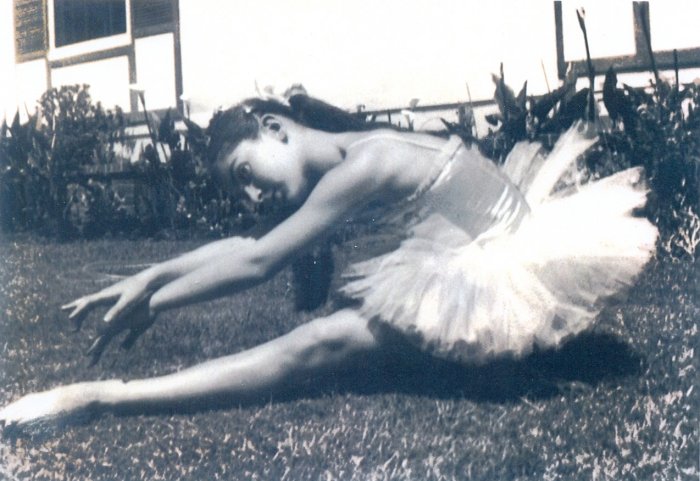 France, 1949 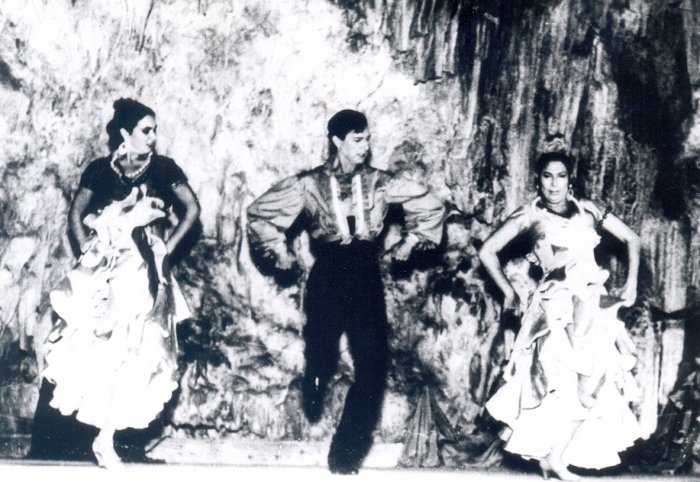 With Alejjandro Vega and Pilar López, 1965 Inspired by the performances of Roberto Ximenez and Manolo Vargas, Ms. Mandelik decided to move to Spain, embarking on an intense period of study of Spanish dance and culture. In 1962 she became a featured soloist with the Ballet Español de Pilar López. She also performed with Antonio, Alejandro Vega, Mario Maya, Carmen Mora and Rafael Aguilar. During this period she remained active in Classical Ballet, appearing regularly during the opera seasons of Madrid's Teatro de la Zarzuela. At the age of 27, with a brilliant future before her in Europe, her creative inquisitiveness drove her to India to study the ancient art of classical Indian dance. Arriving in India, the Indian media heard that a recognized Spanish dancer was in town and she was invited to perform at the Filmfare Awards Ceremony, after which she was asked to dance in the film Suhana Safar with Sharmila Tagore and Shashi Kapoor. From 1968 to 1972 she studied in Chennai (Madras) at Rukmini Devi's renowned Kalakshetra academy, and with the Dhananjayans at their Bharata Kalanjali academy. Returning to Spain, Ms. Mandelik's primary desire was to find a way in which to combine the three modes of expression which had formed her artistic sensibility. An intense international schedule of work with Classical and Spanish Ballet companies and Indian dance recitals led to the formation of her first company, The Mandelik Dance Company, in 1978. As performer, choreographer and director, she forged a company in which Classical Ballet was the predominant discipline, but where Spanish and Indian dance could share the same program. Another focal point of this period was the Ballet Clásico de Luis Fuente in which Ms. Mandelik collaborated as teacher, rehearsal coach, choreographer and performer. In this capacity she trained many dancers who later went on to perform with both Spanish national dance companies. 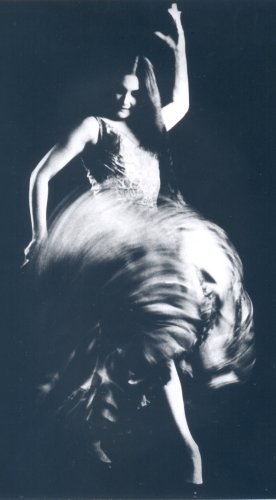 1968 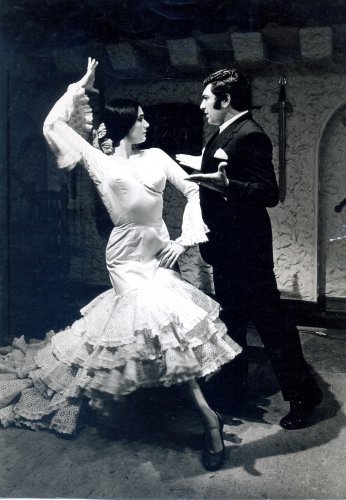 With Flamenco singer Enrique Heredia in Tokyo, 1971 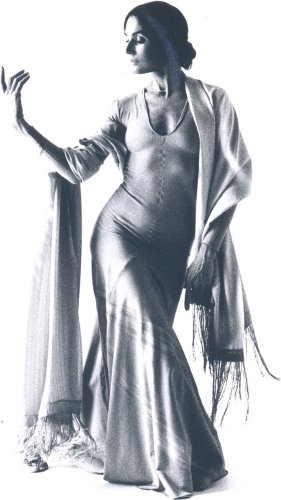 El Puerto, choreography by José Granero, photo by Elke, 1981 Simultaneously with the activities of her own company, she performed in the International Gypsy Festival in Grasse (France) representing India, starred in the De Beers Diamonds Gala with José Granero's Grandes Figuras de la Danza and the Ballet Español de Rafael de Córdova, choreographed programs for Spanish Television and appeared in films in Spain and India. Her dance partners included such international figures as Luis Fuente (star of the Joffrey Ballet, London Festival Ballet, etc.), José Antonio (director of the Ballet Nacional de España), Nacho Duato (director of the Compañía Nacional de Danza) and Hans Wrona (principal dancer, choreographer and ballet master of the Mannheim, Kassel, Wurzburg and Leipzig State Theaters). In 1982 she was invited by Micha Van Hoeck to Milan's Teatro alla Scala as his assistant choreographer, ballet mistress and soloist in Orfeo, a ballet commemorating the Fifth Centenary of Leonardo da Vinci. 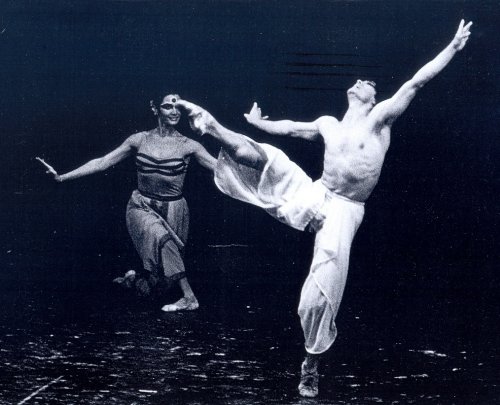 Co-choreography Apsara with Luis Fuente, 1979 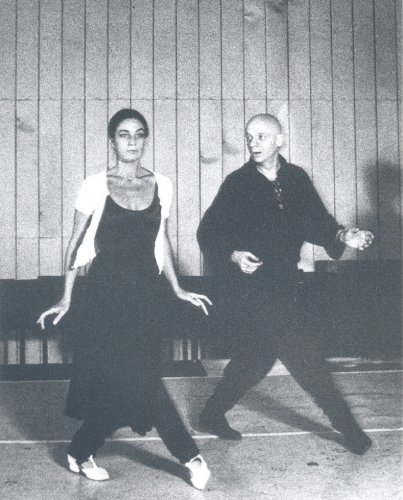 With choreographer Micha Van Hoeck, 1982 Since 1994, Ms. Mandelik has participated in many prestigious international dance events, among which are the Sixth All-Star Gala International Dance Day in honor of Pilar López and Mariemma, and the Gala de Estrellas de la Danza of Lanzarote. At the Fifteenth Natya Kala Conference at the Sri Krishna Gana Sabha in Chennai, she was awarded for her dissertation on the subject of male dancers in Classical Ballet and Spanish Dance. In 1995 she formed her second company, The Gloria Mandelik Dance Company, which was featured during several seasons of the Madrid en Danza Festival. For one of her productions she invited the Dhananjayans' son, Satyajit, to come from India to dance in her ballet, The Elements. Since 2001, two of the highlights of her career have been an invitation by Pilar López to collaborate in recreating the Concierto de Aranjuez for the Ballet Nacional de España (Ms. Mandelik had performed in this very ballet with Pilar López's company in the 1960s) and the publishing by the Indian Embassy of the book India y España, 2000 años de relaciones (India and Spain, a 2000-year relationship). The book includes an illustrated chapter dedicated exclusively to Mandelik's work. At its presentation she was introduced to Her Majesty Queen Sofia of Spain as an artist whose work has had a catalyzing influence on the dissemination of Indian dance in Spain. As a Paris critic said, "Gloria Mandelik has taken the initiative to study Classical dance in India and master it to perfection, which proves that culture is universal and has no national boundaries." Between 2001 and 2006 Ms. Mandelik combined her choreographic activities with those of a regular guest teacher of Classical Ballet during the summer courses at the Ballet Hispánico of New York, the Harrisburg Dance Conservatory and Franklin & Marshall College. 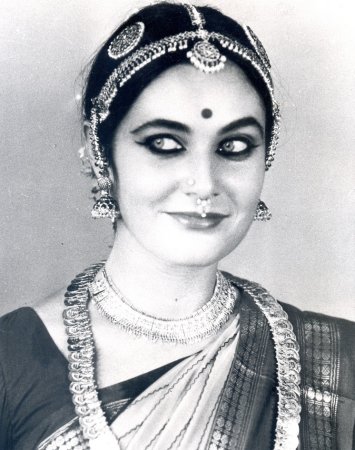 Photo by G.K.Vale, 1970 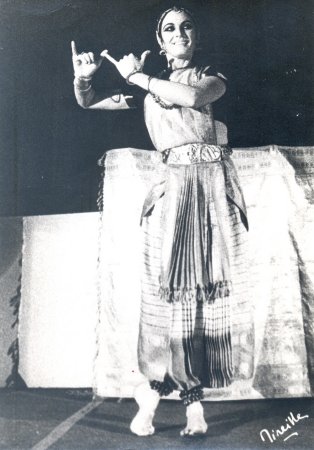 Paris, UNESCO, 1975 2011 saw the culmination of one of Gloria Mandelik's dreams when the Gloria Mandelik Dance Company was invited by the Indian Council for Cultural Relations (ICCR) to tour India. The company performed in Chennai, Mumbai and New Delhi, to great public and critical acclaim. As one reviewer wrote: "Telling a story, especially to an audience that may or may not understand the intricacies of a dance form, is always a gamble. But during their Chennai stop of their tour of India, the Gloria Mandelik Dance Company almost made one believe in princesses, celestial chariots, magical talking animals and spirits. The Spanish dance company opened with The Castle of a Hundred Windows at the Music Academy on Tuesday. The story of Bashtet, the magical cat, revolves around her transforming into a princess to find her prince, and how she loses him. When she goes looking for him with her spirit, she is invited by the princesses of the sun and moon to a dance in a magnificent ballroom, where she finds her prince again. But it turns out that she is invisible. She prays to goddess Parvati to make her visible to reunite with her love. When everyone suddenly disappears into thin air and she returns to being just a black cat, Bashtet is left to wonder about her reverie, whether or not to go back to the outside world or stay sheltered within the palace. The portrayal of the sorrow, happiness, love and limitless opportunities that the windows in her castle represented were impressive in so many ways. The routines of the black cat in her jet black bodysuit were well-choreographed with the obvious addition of pas da basques (jump of a cat). The foites of the sun princess were nearly perfect, strong and a delight to watch. And when all the characters came together on the stage in the ballroom scene, it was a riot of faultlessly synchronised arabesques, altitudes, jetes and pirouettes. In their second number Thirmanam, dancers explored the rhythm of Bharatanatyam, interpreting the beats with ballet, flamenco and Bharatanatyam itself. The foreign dancers were joined by an agile Divya Shiva Sundar for this piece. It was a visual delight when the women dancers, all dressed in the same shade of vibrant pink, performed their respective dances to traditional Indian music and were interrupted by the blur of a male dancer dressed in a silk angavastram, effortlessly leaping across the floor. The solo flamenco performance by Silvia Pinar beautifully captured the way the Spanish literary character Carmen longs for love, but enjoys her freedom at the same time. The solo by Xavier Benaque, for his strong demeanor and brilliant feet, is a must mention. The final act that paid homage to the five elements of nature was a fitting finish. Each element was portrayed using a different style of dance, all of which beautifully stressed the symbolism of different human races being equal. The interdependence of the elements was skillfully brought out on stage, with Bharatanatyam dancer Anand Satchidanandan shining as the earth. The elements prostrated themselves before ether, the universal protective mother. When the routine ended with ether blessing the elements with an act of dhrishti, one had to but come to the conclusion that dance was indeed a universal language." -The New Indian Express; 24 November 2011 There are many fascinating anecdotes in Ms. Mandelik's life, but there are two which are particularly telling. At the age of 4 she was asked what she wanted to be someday to which she answered: a dancer, because it is my religion. Years later she learned that the universe was created by God's cosmic dance. Rukmini Devi would drop in on the classes at her Kalakshetra school to see the progress of the students. During one such class she brought it to a halt to note that Mandelik would master the body postures of Bharatanatyam thanks to her Classical Ballet training, as well as the rhythmic talas of Indian music and dance thanks to her Flamenco experience. The fact that Gloria Mandelik has rigorously undertaken, with true Renaissance spirit, and assimilated such different dance forms, and the unprecedented and label-defying nature of her work, make her one of the most original personalities in the dance world today. José Luis Greco is an American composer, orchestrator of Ravi Shankar's 2nd sitar concerto Raga-Mala. www.grecomusica.com Post your comments Please provide your name and email id along with your comment. All appropriate comments posted with name and email id in the blog will also be featured in the site. |